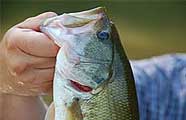All About Bass Fishing - Guide To Mid-Range Depths 10' to 25'
By Rick Seaman and Dan Westfall
 Bass spend a great deal of time in this depth range. During times when bass hold in deeper water, they move up to this depth range to feed. When bass are moving shallow to feed, they return to this holding area when they leave the shallows. Understanding why the bass are in the mid range can be the key to catching them.
Bass spend a great deal of time in this depth range. During times when bass hold in deeper water, they move up to this depth range to feed. When bass are moving shallow to feed, they return to this holding area when they leave the shallows. Understanding why the bass are in the mid range can be the key to catching them.
3 Most Important Factors About Mid-Range Fishing For Bass
- Bass spend a great deal of their time in mid depths, moving shallower to feed or deeper to hold.
- Bass are in mid depths at different times of the year and different times of the day for a variety of reasons.
- Mid depth bass tend to school and are often easier to catch than bass holding in deeper water.
3 Most Effective Fishing Methods & Lures
- Texas-style worms fished on structure in and around cover elements.
- All types of jigs rigged open hook or weedless to allow for fishing in a variety of cover.
- Drop-shot worms and Carolina-rigged worms.
Mid-range depths are where bass spend a great deal of their time
 The term “deep” varies across the country. In many western lakes 20’ deep may be shallow because the majority of lakes are 100’ deep or more. In the eastern part of the country, 10’ may be considered quite deep because the overall lake is relatively shallow. Also, one would likely find different types of cover in mid-range depths from one coast to the other.
The term “deep” varies across the country. In many western lakes 20’ deep may be shallow because the majority of lakes are 100’ deep or more. In the eastern part of the country, 10’ may be considered quite deep because the overall lake is relatively shallow. Also, one would likely find different types of cover in mid-range depths from one coast to the other.
Begin working the 10’ range using reaction type lures like spinnerbaits, deep diving crankbaits, lipless crankbaits and swim baits in the upper region of this range. You may also fish these lures at a 10’ depth over cover in 20’ of water as well.
If the bass are deeper in the cover at these depths, use worms and jigs to get to where the bass are holding. When the bass are in this depth range and active, work the area quickly to make as many presentations as possible during the active period. If the bass are not actively feeding, slow down the presentation and work the cover more thoroughly.
AA Bass Fishing Knowledge Base
- Bass Fishing Overview
- Life Cycle Of Bass
- Seasonal Bass Migration
- Bass Migration - Mid to Late Winter
- Bass Migration - Spring
- Bass Migration - Early Summer
- Bass Migration - Late Summer
- Bass Migration - Fall
- Bass Migration - Early Winter
- Fishing For Bass
- It's Now WHAT You Throw, It's WHERE
- Research The Fishery Before You Go
- Review Contour Maps
- Types Of Cover Used By Bass
- Bass Fishing In Grass Beds
- Bass Fishing In Wood & Timber
- Bass Fishing In Brush & Vegetation
- Establishing Patterns
- Learn To Recognize Bites
- Review Lunar Tables
- Choose The Right Lures
- Find Bass Based On Conditions
- Conditions - Fold Fronts
- Conditions - Wind
- Conditions - Cloudy Days
- Conditions - Fishing In The Rain
- Conditions - Water Clarity
- Conditions - Rising Water
- Conditions - Falling Water
- Conditions - Fishing At Night
- Equipment & Tackle
- Equipment - Fishing Rods
- Equipment - Fishing Reels
- Equipment - Fishing Line
- Equipment - Fishing Lures
- Fishing With Live Bait
- Shallow Water Techniques, 0 -10'
- Shallow Fishing - Spinnerbaits
- Shallow Fishing - Crankbaits
- Shallow Fishing - Top Water
- Shallow Fishing - Pitching & Flipping
- Shallow Fishing - Artificial Worms
- Shallow Fishing - Jigs
- Shallow Fishing - Flukes
- Shallow Fishing - Stick Worms
- Shallow Fishing - Swimbaits
- Fishing Mid Range Depths, 10' - 25'
- Mid Depth - Spinnerbaits
- Mid Depth - Deep Diving Crankbaits
- Mid Depth - Artificial Worms
- Mid Depth - Jigs
- Mid Depth - Swimbaits
- Fishing Deep Water & Structure
- Fishing Deep Water - Jigs
- Fishing Deep Water - Jigging Spoons
- Fishing Deep Water - Artificial Worms
- Planning Your Attack
- Bass Fishing Questions & Answers
- Conservation - Protect The Fishery
Bass information by state
101624
Fishing Information



